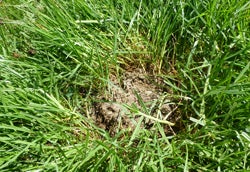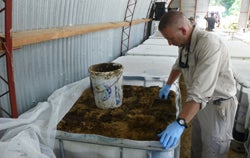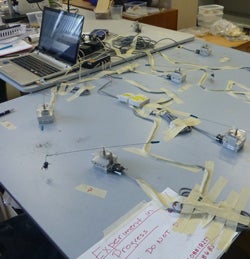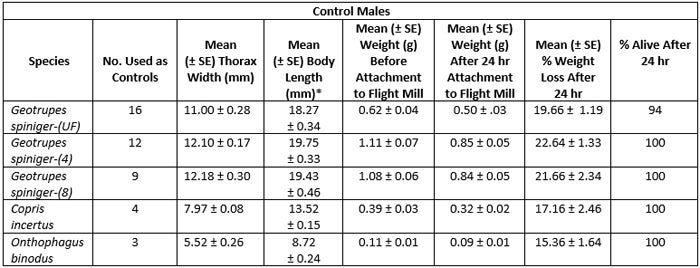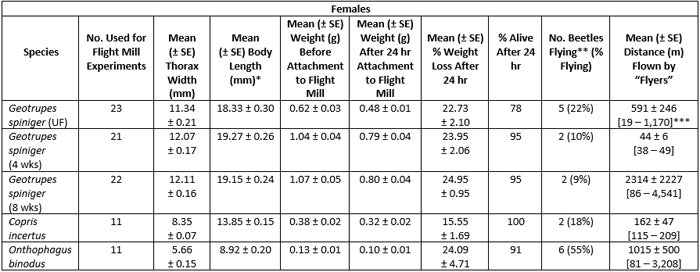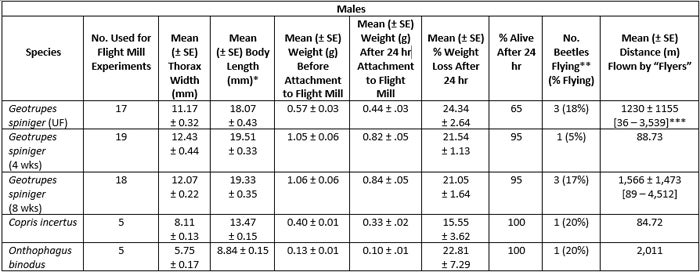Dispersal Capabilities of Three Non-Native Dung Beetles Released in New Zealand for the Biological Control of Cattle Dung
Background and Project Overview: New Zealand (NZ) is an agriculturally intensive country that relies heavily on dairy cattle and sheep farming to generate income. Because New Zealand lacks a significant native terrestrial mammal fauna it subsequently lacks an essential co-evolved insect community associated with large herbivorous mammals, these being coprophagous insects that specialize on eating dung. New Zealand’s native dung beetle fauna is impoverished, just 15 species in three genera, all of which are small (2-15 mm in length), flightless, and are forest inhabitants that probably feed on native lizard and bird manure. None of these native NZ dung beetles have been recorded feeding on the dung of exotic mammals in open pastures. Accumulation of dung in NZ’s pastures is a significant problem. It has been estimated that at any one time 700,000 ha of grassland is covered in sheep, cattle, horse, deer, pig, and goat feces. In the absence of specialized insects and depending on the time of year, this excrement may take weeks to months to decompose. During this time significant problems associated with slowly decomposing animal manure on the soil surface are observed. First, pasture productivity is reduced as less grass is available for grazing and animals avoid feeding on areas around dung pats (Figs. 1A and 1B).
| Fig. 1A (Above) Clumps of green grass in a grazed field shows forage avoidance by dairy cows because of decomposing cow manure that has been overgrown by pasture grasses. |
| Fig. 1B (Above) Grass has been parted to show decomposing manure that has been overgrown by pasture that cows will not feed on because of this decomposing dung. |
Animal feces contribute to nutrient loading that contaminates water, and run off from pastures reduces ground water, stream, and river quality. Filth fly populations that breed in dung are problematic and annoy life stock and humans, and spread disease causing microbes. Additionally, slowly decomposing dung is a source of parasitic roundworms increasing the need for oral or topical drenches of life stock to prevent or cure infections.
In response to this significant ecological and economic problem, Landcare Research in NZ has undertaken an ambitious program to reduce dung in pastures. Landcare Research is a Crown Research Institute operated by the NZ Government whose core purpose is to manage terrestrial biodiversity and land resources. The dung biocontrol program has involved the recent (starting in 2012) approval for release from quarantine of 13 species of dung beetles that have been imported from different parts of the world (e.g., Africa, Europe, and South America) that specialize on processing bovine (i.e., cow) and ovine (i.e., sheep) feces. These different dung beetle species are expected to be complementary in their activity because they have different climatic (warm and humid vs. cold and dry) and soil requirements (e.g., clay vs. loam), reproduce at different times of the year (i.e., summer vs. winter), and activity periods (i.e., species are either crepuscular, diurnal, or nocturnal in their activity). These beetles process dung by excavating tunnels under piles of feces. Tunnels are then provisioned with the overlying manure that is harvested and deposited into excavated chambers. Female beetles oviposit into this harvested material. Developing dung beetle larvae feed on dung deposited by adults in these tunnels and brood chambers. Provisioning of subterranean tunnels quickly removes dung from the soil surface and larval feeding integrates processed material into the soil which helps improve soil fertility and structure.
Because this dung biological control program is in its infancy, it provides an ideal opportunity to study the invasion patterns of incipient populations of biocontrol agents, these being exotic species of dung beetle released in NZ. To assess invasion propensity the flight characteristics of three species of dung beetle were characterized using computerized flight mills. We have completed similar studies for three species of pest beetle, the gold spotted oak borer in California (Lopez et al., 2014), red palm weevil in Saudi Arabia (Hoddle et al., 2015), and the coconut palm weevil in Indonesia (Hoddle and Hoddle 2016). These laboratory studies used custom-made computerized flight mills to measure flight activity (e.g., distances flown and velocity) and periodicity (i.e., time of day or night insects fly) of test insects. Covariates such as sex, mating status, size, color morph, and age can be analyzed to determine their effects on recorded flight metrics.
| Fig. 2 Dung beetle mass rearing containers (~1.25m3) hold specially prepared soil for G. spiniger to create underground brood chambers. Fresh cow manure (field collected and in the bucket) is laid on soil surface for beetles to feed on. Surface manure is pulled down through vertical tunnels to provision horizontal subterranean brood chambers. Females lay eggs in manure in brood chambers on which larvae subsequently feed and develop. Klemperer (1979) provides details on G. spiniger nesting behavior. |
Dispersal is a critical phenomenon that affects the invasive potential of exotic organisms but it is an area of invasion biology that is poorly understood because factors influencing dispersal and quantification of parameters describing dispersal are difficult to define and measure (Lockwood et al. 2013.) Further, dispersal parameters for individual study organisms are difficult to quantify via field studies. This difficulty is due to the large number of individuals that would have to be studied and “marked” (e.g., GPS tags, protein, or color marks) and the number of monitors or traps (e.g., pheromone traps) that would have to be deployed over very large distances to gather data on sufficient numbers of study organisms to quantify underlying flight parameters (i.e., distances flown). Flight mills are ideally suited for quantifying parameters underlying dispersal because large numbers of insects can be flown and covariates such as age, sex, mating status, temperature, percentage weight loss, and diet can be controlled and statistically analyzed with quantified flight parameters (e.g., distance flown in a 24 hr period) to determine their effects on flight activity. These types of dispersal data can be built into distribution models that can be used to predict movement and distance patterns (Chapman et al., 2012; Kok et al., 1996) for incipient dung beetle populations in varying regions of NZ. For example, theory suggests that sex-biased dispersal can have a significant impact on invasion success because if one sex dispersers faster than the other, incipient populations at the leading edge of the invasion may be more susceptible to Allee effects or stochastic events that cause extinction (Miller et al., 2011). Consequently, this work was undertaken to provide a “baseline” of flight capabilities for three dung beetle species and these dispersal data would provide hypotheses against which field experiments and observational distribution data from beetle recoveries could be tested.
| Fig 3. Photos of dung beetle species used in flight mill assays. (A) Copris incertus (adults are approximately 15-17 mm long; native to Mexico, Central and South America. Introduced into NZ in 1956 and flight is nocturnal). (B) Onthophagus binodus (adults are approximately 12-14 mm long; native to South Africa. Flight is diurnal). (C) Geotrupes spiniger (adults are about 23-26 mm long; native to Europe, parts of the Middle East, and Pakistan. Introduced into NZ in 2012 and flight activity is at dusk and dawn) Photos from dungbeetle.org |
Experimental Procedures: Three different species of dung beetle were used for flight studies: (1) Geotrupes spiniger Marsham (Coleoptera: Geotrupidae); (2) Copris incertus Say (Coleoptera: Scarabaeidae), and (3) Onthophagus binodis (Thunberg) (Coleoptera: Scarabaeidae). Adult G. spiniger were harvested from a mass rearing facility (Fig. 2) managed by Dung Beetle Innovations at three different time intervals: (1) newly emerged adult beetles, (2) adult beetles that had fed for four weeks post-emergence, and (3) adult beetles that were at least 8 weeks of age. For each of these three age classes, a total of 40 beetles were flown, for a grand total of 120 G. spiniger flown on flight mills.
A total of 16 C. incertus and 16 O. binodus (i.e., 32 beetles in total) were flown on flight mills. These adult beetles were field collected from infested cow manure sitting on top of pasture grasses. Photos of beetles are shown in Fig. 3.
| Fig. 4. Flight mills set up in the laboratory. Beetles are tethered to rotors which turn when beetles fly. Each rotation is ~ 1m. Flight data is transmitted via cables to a processor that in turn passes the data to the laptop computer which records flight activity for individual beetles. A maximum of 8 beetles can be flown at one time. Flying beetles can be viewed by clicking here |
Flight mills (see Lopez et al. 2014 and Hoddle et al. 2015 for details on flight mills) (Fig. 4) were set up in a laboratory at Landcare Research in East Tamaki, Auckland New Zealand. Experimental beetles were tethered to flight mills and left for 24 hrs. Customized computer software recorded flight activity over the 24 hr period and flight data were analyzed in Microsoft Excel using a custom written macro.
Results
Flight Activity of G. spiniger. A total of 17, 19, and 18 male G. spiniger from newly emerged and unfed, 4 weeks, and 8 weeks of age categories, respectively, were flown on flight mills. “Flyers” (males and females [see below for summary of female flight statistics]) were classified as beetles that flew more than 5 m per bout with a minimum velocity of 0.64m/s. Using this discriminant to separate “flyers” from “non-flyers”, 18%, 5%, and 17% of test beetles in the unfed, 4 weeks, and 8 weeks of age categories flew (Table 1). On average, males that flew and were newly emerged and unfed, 4 weeks, and 8 weeks of age, flew, on average, 1.23 km, 0.09 km, and 1.57 km, respectively. Experimental beetles tethered to flight mills lost ~21-25% of body weight in 24 hr (Table 1). Unfed control males not tethered to flight mills and held individually in clear ventilated plastic containers in the laboratory lost 20-23% body weight in a 24 hr period (Table 3), which was similar to tethered beetles.
A total of 23, 21, and 22 female G. spiniger from newly emerged and unfed, 4 weeks, and 8 weeks of age categories, respectively, were flown on flight mills. Of these tethered beetles, 22%, 10%, and 9% flew in the unfed, 4 weeks, and 8 weeks of age categories. These beetles flew on average, 0.59 km, 0.04 km, and 2.3 km, respectively (Table 2). Female G. spiniger tethered to flight mills lost 23-25% body weight (Table 2) and unfed control females, held individually in clear ventilated plastic containers, lost 19-26% body weight in a 24 hr period (Table 4).
Flight Activity of C. incertus: Five male (Table 1) and 11 female (Table 2) field collected C. incertus were flown on flight mills. Of these beetles, 20% and 19% of male and female beetles flew more than 5 m per bout with a minimum velocity of 0.64m/s and were considered “flyers.” On average, male (Table 1) and female (Table 2) C. incertus flew 0.08 km and 0.16 km, respectively. Tethered (Table 1 and 2) and unfed control (Table 3 and 4) male and female C. incertus lost 16-17% of their body weight in a 24 hr period.
Flight Activity of O. binodus: Five male and 11 field collected O. binodus were flown on flight mills. Of these beetles, 20% of males (Table 1) and 55% of female (Table 2) O. binodus flew more than 5 m per bout with a minimum velocity of 0.64m/s. The averaged distances flown by male and female O. binodus were ~2 km (Table 1) and ~1 km (Table 2), respectively. Tethered male (Table 1) and female (Table 2) beetles lost 23-24% of their body weight in a 24 hr period. Untethered unfed control males (Table 3) and females (Table 4) lost 15-26% of their body weight in 24 hr.
Conclusions: Overall a low proportion of G. spiniger across the three different age categories tested, flew on flight mills. Of those beetles flying, the average distances covered ranged from a few hundred meters to 1.6 km. The strongest male and female beetles were capable of flying ~4.5 km in a 24 hr period. These data suggest that the majority of G. spiniger in the three age categories tested, unfed and newly emerged, 4 weeks, and 8 weeks of age are not likely to engage in dispersal flights that cover significant distances. These results may be an artifact of laboratory conditions (i.e., lack of environmental stimuli that initiate and sustain flight) and the flight mill set up in general. There are significant recognized shortcomings to flight mill studies for assessing an insect’s capacity for dispersal (Taylor et al. 2010). The flight capacity of field collected G. spiniger warrants investigation as these beetles, especially reproductively mature adults, which may exhibit a propensity to engage more readily in dispersal flights. Evaluation of the flight activity of field collected G. spiniger was not possible for this study as these beetles are currently undergoing releases (the first releases were made in 2012 and ~10,000 beetles have been released so far) into farmlands and field populations are currently too low to easily allow field collections of beetles for use in experiments.
Significantly fewer C. incertus and O. binodus were tested on flight mills and the flight capacity of these field collected beetles may be underestimated as a consequence. The low number of C. incertus and O. binodus flown was a result of time restrictions and priority being given to studying G. spiniger. It is likely that these dung beetle species may benefit from human-assisted dispersal into suitable habitat if agricultural areas are to be colonized at a more rapid rate than what may occur if beetles are left to disperse naturally.
References Cited
- Chapman, D.S., C. Dytham, and G.S. Oxford. 2012. Modeling population redistribution in a leaf beetle: an evaluation of alternative dispersal functions. J. Anim. Ecol. 76: 36-44.
- Hoddle, M.S., C.D. Hoddle, J.R. Faliero, H.A.S. El-Shafie, and A.A. Sallam. 2015. How far can the red palm weevil, Rhynchophorus ferrugineus (Olivier) (Coleoptera: Curculionidae) fly?: Results of computerized flight mill studies using field captured weevils. J. Econ. Entomol. 108: 2599-2609.
- Hoddle, M.S. and C.D. Hoddle. 2016. How far can the palm weevil, Rhynchophorus vulernatus, fly? J. Econ. Entomol. 109: 629-636.
- Klemperer, H.G. 1979. An analysis of the nesting behaviour of Geotrupes spiniger Marsham (Coleoptera: Scarabaeidae). Ecol. Entomol. 4: 133-150.
- Kok, M., M.A. Lewis, P. van den Driessche. 1996. Dispersal data and the spread of invading organisms. Ecol. 77: 2027-2042.
- Lockwood, J.L., M.F. Hoopes, and M.P. Marchetti. 2013. Invasion Ecology. Wiley-Blackwell, West Sussex, U.K.
- Lopez, V.M., M.N. McClanahan, L. Graham, and M.S. Hoddle. 2014. Assessing the flight capabilities of the goldspotted oak borer (Coleoptera: Buprestidae) with computerized flight mills. J. Econ Entomol. 107: 1127-1135.
- Miller, T.E.X., A.K. Shaw, B.D. Inouye, and M.E. Neubert. 2011. Sex-biased dispersal and the speed of two sex invasions. Am. Nat. 177: 549-561.
- Taylor, R. A. J., L. S. Bauer, T. M. Poland, and K. N. Windell. 2010. Flight Performance of Agrilus planipennis (Coleoptera: Buprestidae) on a flight mill and in free flight. J. Insect Behav. 23: 128-148.
Table 1. Summary statistics for male beetles attached to flight mills. |
|
*Body length was measured from the anterior margin of the thorax to posterior margin of abdomen |
Table 2. Summary statistics for female beetles attached to flight mills. |
|
*Body length was measured from the anterior margin of the thorax to posterior margin of abdomen |
Table 3. Summary statistics for male beetles that were not attached to flight mills (i.e., control beetles). |
|
*Body length was measured from the anterior margin of the thorax to posterior margin of abdomen |
Table 4. Summary statistics for female beetles that were not attached to flight mills (i.e., control beetles). |
|
*Body length was measured from the anterior margin of the thorax to posterior margin of abdomen |
More Media on the Dung Beetle
|
Civil Eats: Dung Beetles are key to healthy pasture. Now they may also help make produce safer
|
|

